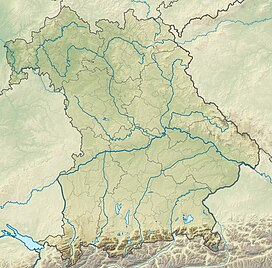Ochsenkopf (Fichtel Mountains)
| Ochsenkopf | |
|---|---|

The Ochsenkopf, seen from the Waldstein
|
|
| Highest point | |
| Elevation | 1,024 m above sea level (NN) (3,360 ft) |
| Prominence | 254 metres (833 ft) |
| Coordinates | 50°01′50″N 11°48′29″E / 50.03056°N 11.80806°ECoordinates: 50°01′50″N 11°48′29″E / 50.03056°N 11.80806°E |
| Geography | |
| Parent range | Fichtel Mountains |
The Ochsenkopf is the second-highest mountain in the Fichtel Mountains with a height of 1,024 metres (3,360 ft). On its summit is an observation tower (the Asenturm) and a transmission tower for VHF and TV programmes by Bayerischer Rundfunk.
There are cable cars to the Ochsenkopf from south and north. The valley stations are, in the north, in the village of Bischofsgrün and, in the south, in Fleckl, part of the municipality of Warmensteinach.
In winter there is skiing on the Ochsenkopf. In summer a sommerrodelbahn (dry toboggan run) can be used. This is accessible from the northern valley station. In addition since July 2007 there has been a tree-walk (Kletterwald), that can be used by individuals or groups.
The White Main - the right-hand, northern headstream of the River Main - rises just a short distance to the east of the mountain, above the village of Fichtelberg as does the Fichtelnaab, a headstream of the Naab. The European Watershed also runs over the mountain. The Naab flows south towards the Danube, the Main west to the Rhine.
The name "Ochsenkopf" does not appear in old descriptions of the mountains. The first person to write about the Fichtelgebirge, Matthias von Kemnath (actually Matthias Widmann, b 23 February 1429 in Kemnath) reported in 1476: Ein bergk, hoch, weitt, wolbekant ligt in Beiern, gnant der Fichtelberg ("A mountain, high, wide and well-known, lies in Bavaria, known as the Fichtelberg"). In descriptions of the border in 1499 and 1536 the mountain is called Vichtelberg, thereafter the name was extended to the whole mountain region. It is also mentioned in old documents: around 1317 the Lords of Hirschberg were enfeoffed inter alia with the walt zu dem Vythenberge. By the 14th century iron ore was being extracted in the St. Veith Pit on the southern foot of the Ochsenkopf. Vyth → Veit → Fichtel. High-profile local history and name researchers have still not had the last word. The name Ochsenkopf appeared in mining deeds for the first time in 1495, when Lorenz von Ploben from Nürnberg was given the mine on the Fichtelberge "near the Ochsenkopf" as a feoff. That may be the first reference to the head of a steer carved into a rock on the suummit, which can still be seen today.
...
Wikipedia

